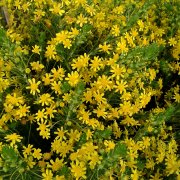Care of the shrub Euryops virgineus or River resin bush |
|
The genus Euryops, family Asteraceae, comprises 100 species of flowering plants native to Africa and the Arabian peninsula. Some species are: Euryops virgineus, Euryops pectinatus, Euryops annae, Euryops mucosus, Euryops walterorum. Common names: Honey euryops, Honey marguerite, River resin bush. This species is native to South Africa. They are fast-growing, highly branched evergreen shrubs that reach 1.5 meters (4.92 feet) in height. The leaves are very small, dark green and webbed in shape; they are usually hidden by the abundant yellow flowers that measure 1 cm (0.39") in diameter. The flowers give off a slight honey aroma. They bloom from late winter to mid-spring. Honey marguerite is used for borders, as isolated specimens, to cover dry areas of the garden, in informal hedges and in pots. It's ideal for Mediterranean coastal gardens due to its resistance to wind and salinity. Euryops honey can be grown in full sun or semi-shade exposure; in semi-shade it produces fewer flowers. It resists occasional frosts. River resin bush tends to grow in sandy and stony soils; it can be grown in any soil that is very well drained. Water moderately, always waiting for the substrate to be well dry. Honey euryops does not need fertilizers. Prune after flowering to maintain a compact appearance and to favor the appearance of flowers the following year. Euryops virgineus is plant resistant to pests and diseases but sensitive to excess humidity. Honey marguerite propagates by seeds sown in spring; Plants that bloom earlier are obtained if they are propagated by cuttings. |
Images of the shrub Euryops virgineus or River resin bush |
Find plants
Euryops virgineus or River resin bush | Care and Growing
© 2026 FavThemes


